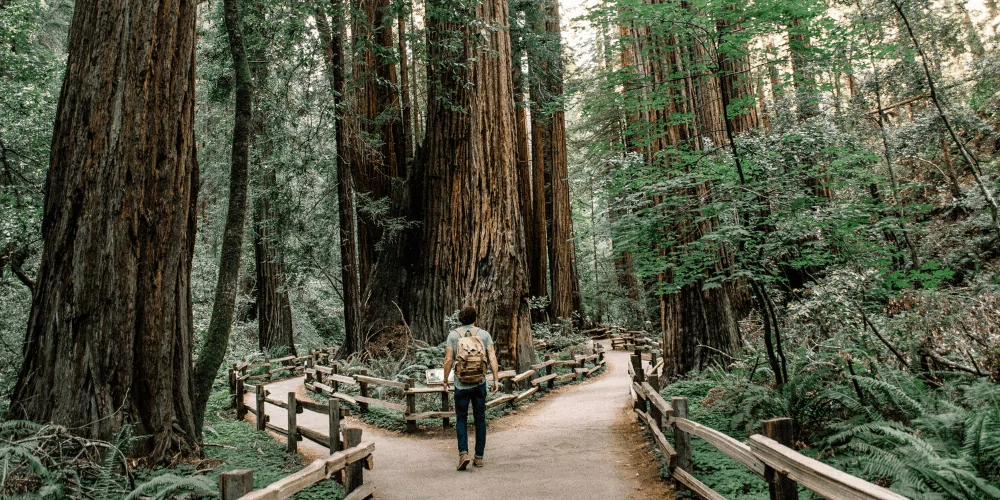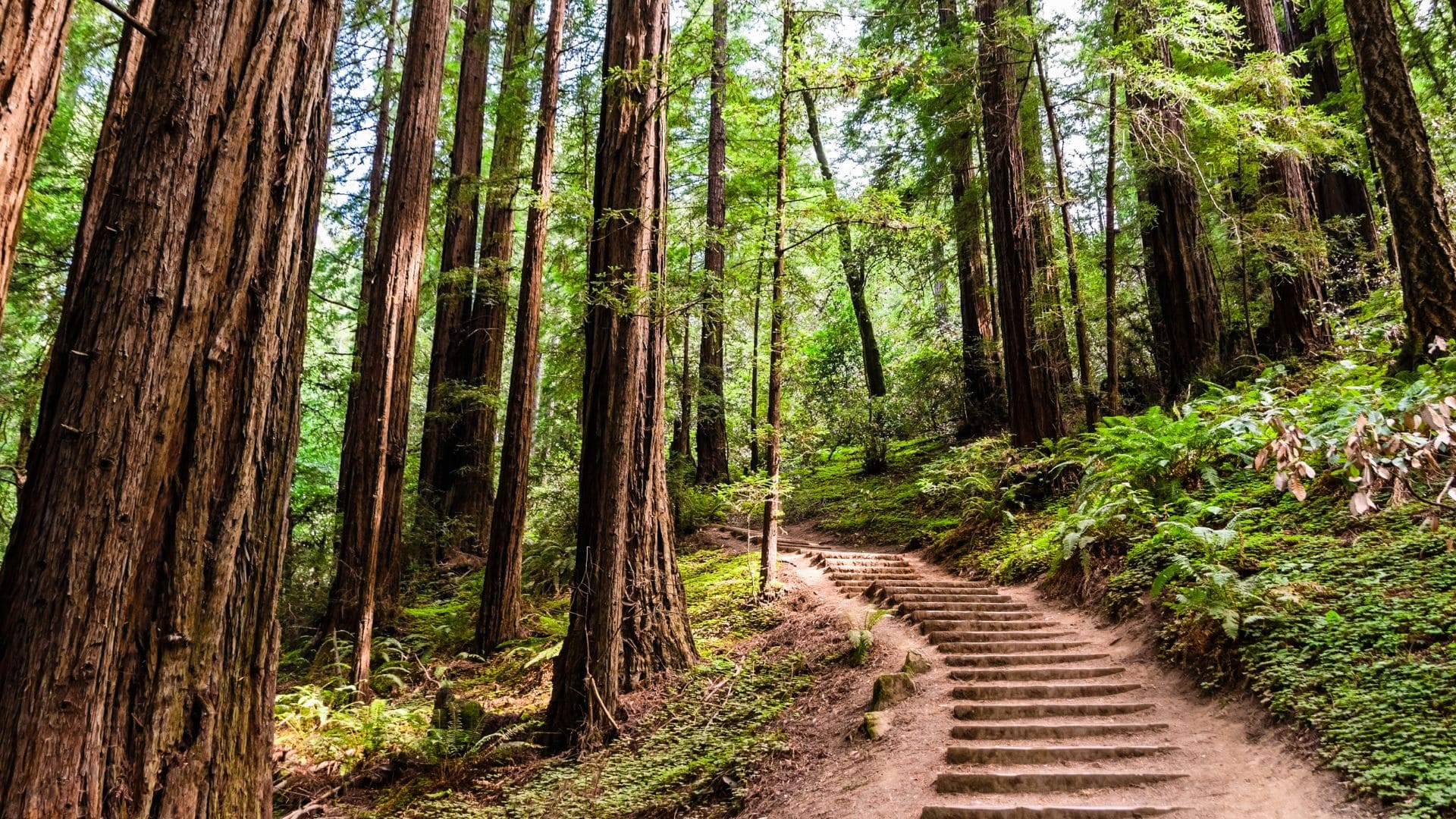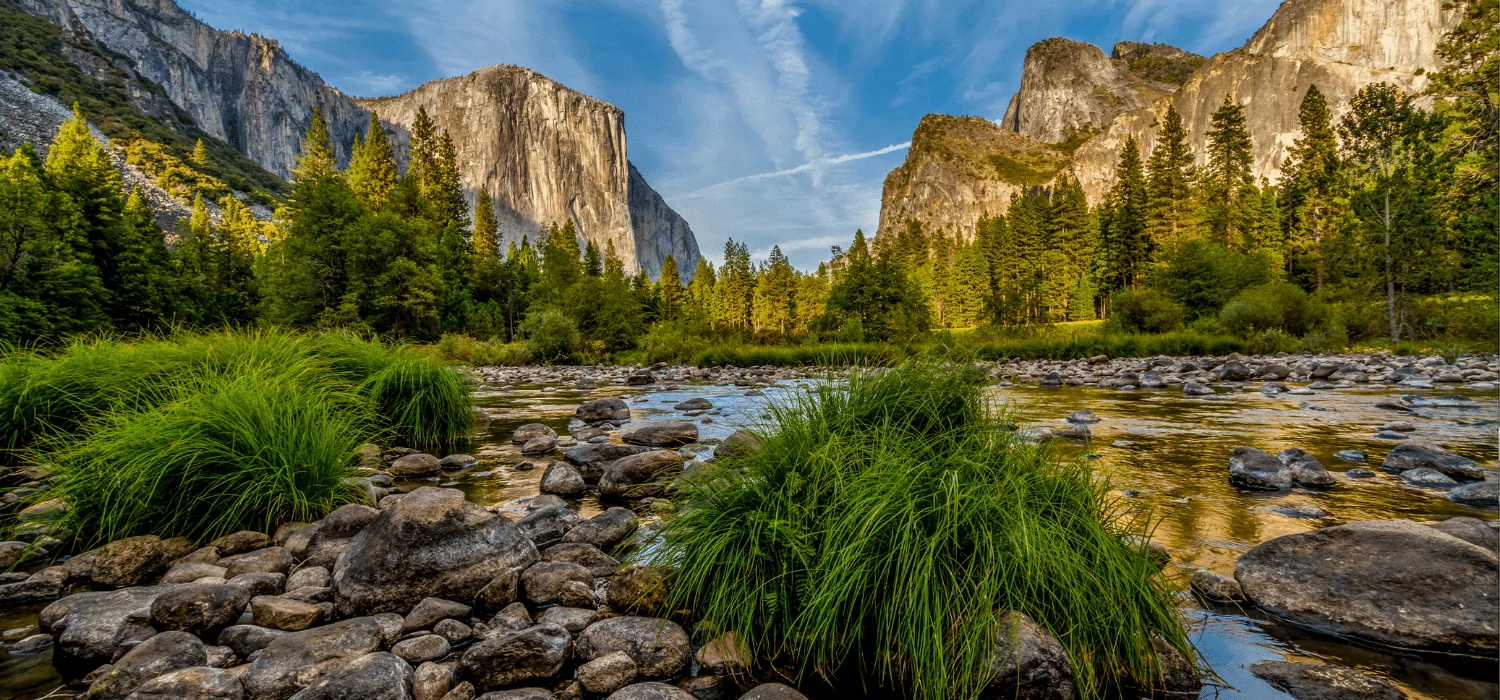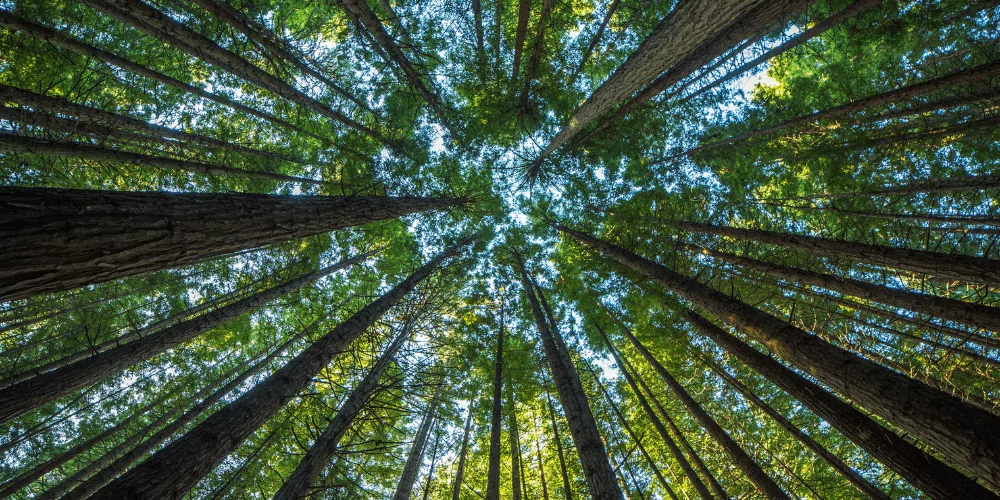Are there redwood forests close to San Francisco? Lucky for you, the answer is YES! Within just a few hours drive of the city there are 15+ wonderful places to see California’s famous giant redwoods. There are even places to see redwoods in San Francisco itself!
In this article we will answer all of your redwoods questions, from where to see the biggest old growth redwoods nearest to San Francisco, to where you can drive through a giant redwood tree, and more. Let’s dive in!
The famous California Redwood Trees
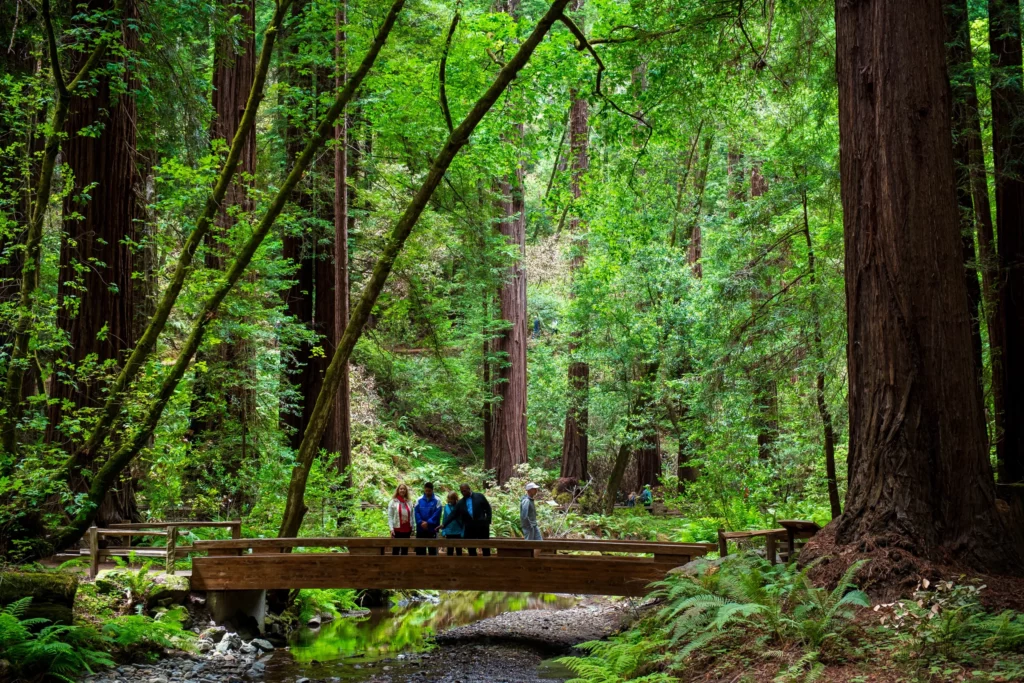
What is it like to walk in a towering redwood forest? The feeling is hard to describe. After spending time among these giant redwoods, our guests have called them “majestic,” “tranquil,” “magical,” or just plain “awesome.”
Northern California’s redwood trees inspired naturalist John Muir and photographer Ansel Adams. Later, U.S. President Theodore Roosevelt described a night camping beneath Yosemite’s redwood trees as “like lying in a great solemn cathedral, far vaster and more beautiful than any built by the hand of man.”
California’s Giants
If you visit Northern California and poke around its wild redwood forests, you’ll find massive trees nearing 400 feet and boasting ages of more than 3,000 years. Before the last ice age, these trees could be found throughout Eurasia, North America, and as far away as New Zealand. Now, these trees are far more rare…but no less amazing.
Redwoods are not only the tallest, but also the largest living things on our planet. Coast redwoods are especially quick growing, gaining 4-8 feet in height a year under ideal conditions. But due to their truly enormous size, mature redwoods actually gain more wood every year than saplings do, simply by growing larger around.
Maybe the most important reason for their enormous size is that redwoods live to a ripe old age. Scientists believe that Giant Sequoias could theoretically go on living and growing forever, as long as they are not toppled by fire, erosion, or by other means.
Thankfully, redwoods have evolved incredible bark which protects them from many of these threats. Up to 12 inches thick, their bark provides excellent insulation which allows the trees to generally survive forest fires. Additional natural defense is provided by the tannins in their bark which help to fend off insects.
What is the difference between Coast Redwoods and Giant Sequoias?
Coastal Redwoods (Sequoia Sempervirens), as their name suggests, are the ocean-loving species. They can only be found in a narrow strip of land along the Pacific Ocean from Santa Cruz, California up into southern Oregon. These giants can grow up to 375’ tall, making them the tallest living organism on the planet.
Their slightly shorter cousin, the Giant Sequoia (Sequoiadendron giganteum), are actually bigger in terms of volume. These impressive trees have been measured at up to 102 feet around and an estimated 2.7 million pounds (General Sherman, Sequoia National Park)! The giant sequoia grow naturally along the western slope of the Sierra Nevada mountains, between 5,000 and 7,000 feet above sea level.
While it is easier to see coast redwoods from San Francisco, due to their range, the giant sequoia should not be overlooked! This article will include places to see both of California’s native redwood tree species near San Francisco.
15 Best Redwood Forests Close to San Francisco
If you’re looking for a redwood forest near San Francisco, you don’t have to travel far. We have selected and profiled below our favorite places to see Coastal Redwoods and Giant Sequoias on a day trip when visiting Northern California.
All are reasonable day trips from San Francisco except for the Humboldt and Kings Canyon groves. It would be better to plan an overnight stay near the trees in those parks. Here is the list arranged by their distance from San Francisco.
Places to See Redwoods & Distances from San Francisco
- Reinhardt Redwood Regional Park 17 miles
- Muir Woods National Monument 19 miles*
- Golden Gate Park – Heroes Grove 4 miles
- Samuel P. Taylor State Park 31 miles
- Butano State Park 51 miles
- Portola Redwoods State Park 51 miles
- Henry Cowell Redwoods State Park 72 miles
- Big Basin Redwoods State Park 76 miles
- Armstrong Redwoods State Natural Reserve 77 miles
- Pfeiffer Big Sur State Park 150 miles
- Calaveras Big Trees State Park 162 miles
- Tuolumne Grove (Yosemite National Park) 175 miles*
- Mariposa Grove (Yosemite National Park) 210 miles
- Humboldt Redwoods State Park 217 miles
- Kings Canyon & Sequoia National Park 237 miles
Okay, ready to go see some redwoods? The following profiles will help you plan your visit to a redwood forest in Northern California!
1. Reinhardt Redwood Regional Park
Distance from SF: 17 miles
Why go? A rare Coastal Redwood forest just minutes from San Francisco.
This other-worldly park containing a coast redwood forest is flourishing just outside the bustling urban center of Oakland, California. This park is a local favorite for hiking, cycling, and horseback riding.
The 1,830-acre park features nearly 40 miles of trails that traverse a varied landscape of second-growth redwoods, evergreens, and grasslands teeming with wildlife such as deer and golden eagles. A favorite is the Stream Trail, which skirts Redwood Creek through lush redwood groves dotted with alien-like fungi.
Know before you go. This park is wonderful for picnicking, so load up on food that you can spread out in one of the park’s scenic picnic areas.
2. Muir Woods National Monument
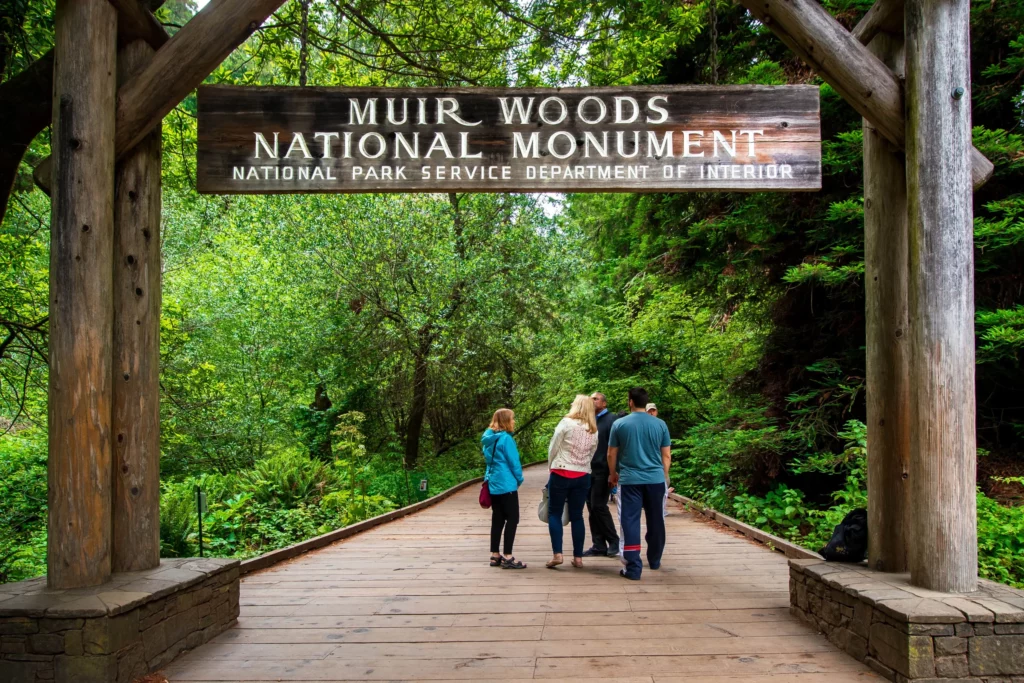
Distance from SF: 19 miles
Why go? Accessible, giant old growth redwoods within an hour drive of San Francisco.
The story of the Muir Woods National Monument goes back to William Kent, a leading conservationist, who in 1905, bought 612 acres of old-growth redwood forest in Marin County and made the space available to visitors. It quickly became one of San Francisco’s most popular attractions.
Thankfully, President Teddy Roosevelt shared his concern for our nation’s wildlands and agreed to have the federal government step in to protect the land. In gratitude to their longtime friend and fellow conservationist John Muir, Roosevelt and Kent agreed that the park would be named in his honor.
Muir Woods is where you will find the largest redwoods near San Francisco, as well as the largest crowds. While the Giant Sequoias to the east are bigger, you really can’t beat this park for huge trees so close to the city, so the crowds are worth it.
Know before you go. If you are going in your personal vehicle, you will need to acquire a parking reservation (https://gomuirwoods.com or call +1 800.410.2419). Food and beverages are available for purchase at the café, but the rangers strictly prohibit picnicking within the park’s boundaries. There is no cell or Wi-Fi service in the park. Download your parking reservation or shuttle ticket in advance.
Traffic congestion and parking at Muir Woods National Monument can be a challenge on busy summer days and weekends. Consider taking public transportation or a bus tour (check out our Muir Woods and Sausalito Tour). A bus takes the place of dozens of cars. The park service—and the trees—will thank you!

Exclusive Muir Woods, Napa & Sonoma Valley Wine Tour
The only wine country tour to combine three Napa & Sonoma Valley wineries with a morning excursion to San Francisco’s stunning Coast Redwood forest – Muir Woods.
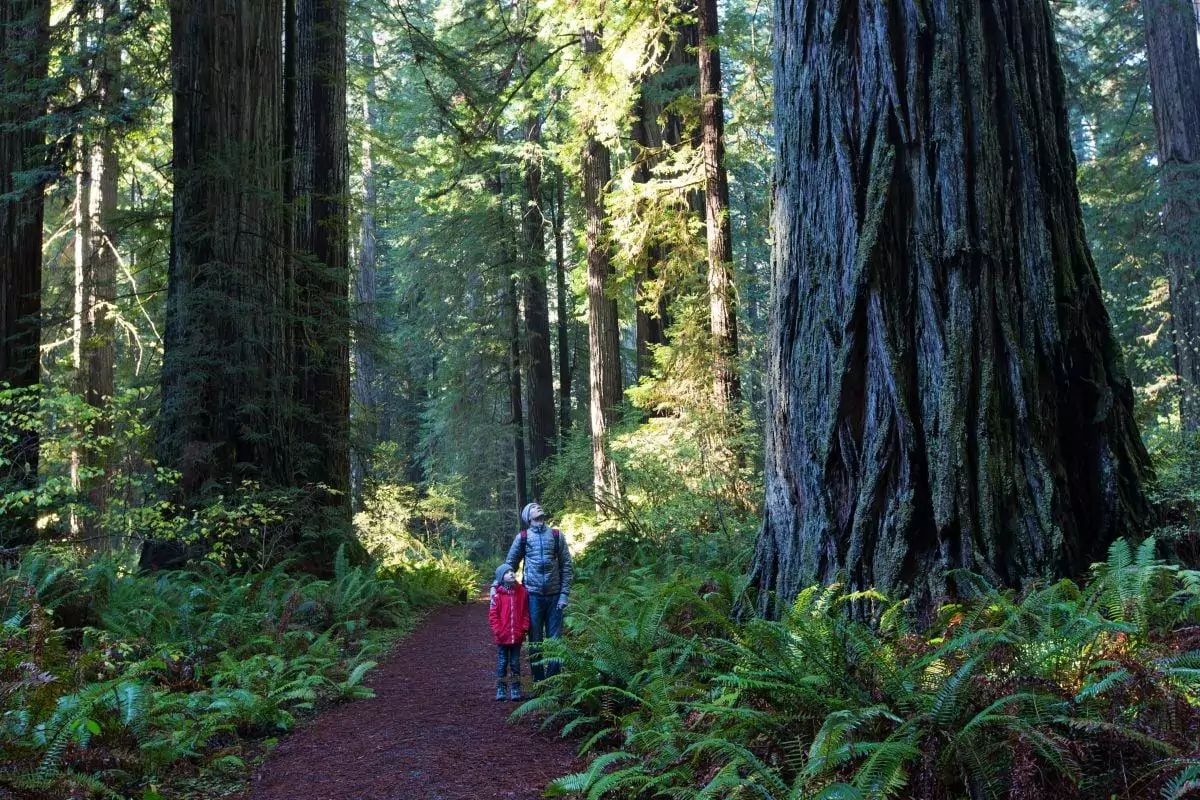
Muir Woods Redwood Forest and Sausalito Morning Tour
This is the only Muir Woods tour with guided audio narration inside the park. Walk under the world’s tallest trees, then enjoy charming Sausalito.
3. Golden Gate Park – Heroes Grove
Distance from SF: 4 miles
Why go? The most convenient way to see redwoods in San Francisco.
Great news! You don’t even have to leave the city to see redwoods! Heroes Grove within Golden Gate Park is a lovely grove of 100 year old coast redwoods directly in the heart of the city. A stop here is an extremely easy way to see redwood trees in San Francisco.
While these trees are small relative to some in the parks further from the city, this is a great option if you can’t manage a trip further out. While there, check out all of the other amazing things to to do in Golden Gate Park.
Know before you go. The key to enjoying a visit to Golden Gate Park’s redwood groves is to limit your expectations. They are wonderfully convenient, and you will get a feel for why these trees are so special, but you really need to travel further out to reach the huge, breathtaking trees.
4. Samuel P. Taylor State Park
Distance from SF: 31 miles
Why go? Lots of amenities for campers and R.V.s like group campsites, cabins, hiking and biking trails, picnic tables, public showers, fire pits, and dump stations.
Samuel P. Taylor was a wealthy entrepreneur who, in the mid-19th century, built a trackside resort property that he thought would appeal to travelers on the local Sausalito-to-San Francisco railroad who were weary of “big city life”. The property passed into California state hands in the 1940s.
The 2,882 acre park is located in densely wooded countryside along steep rolling hills. There’s beautiful coast redwood groves and open grassland to explore. There’s also a wide variety of flowers, oak, laurel and Douglas Fir.
Know before you go. “The Inkwells” are a series of pools along Lagunitas Creek that are good for swimming on hot days. Don’t dive or jump in—they’re not deep enough. From the park, take the Cross-Marin Trail east along the creek to the Inkwells Bridge. From there, it is a short scramble to the swimming hole.
5. Butano State Park
Distance from SF: 51 miles
Why go? Hidden gem state park with varied ecosystems to explore.
While the redwoods here in Butano State Park are second and third growth, due to logging that continued until the 1950’s, it is still well worth a visit. The 40 miles of hiking trails and 39 camping sites offer plenty of recreation.
Butano State Park contains 6 distinct natural communities including the redwood/douglas fir forest, alder woodland, coastal grassland, and chaparral. Explore each to discover different native plants and wildlife like california newts, calypso orchids, coyotes, or even bobcats.
Know before you go. The Six Bridges Trail is an excellent 1.0-mile introduction to the park.
6. Portola Redwoods State Park
Distance from SF: 51 miles
Why go? Serene State Park with 18 miles of trails near the bustle of Silicon Valley.
This lesser known state park is 2,800 acres of old growth redwoods with an understory dominated by huckleberry. Hiking trails range from the quick 0.5 mile Old Tree Trail to the 13-mile journey along Bear Creek and Peter’s loop trails.
The Old Tree Trail leads, fittingly, to Old Tree, a redwood over 300 feet in height and over 1,000 years old. This makes for a great warm up hike before further exploration along meandering creeks to waterfalls and, of course, more redwoods.
Know before you go. Drive carefully on the steep and narrow road down into the park. Reservations can be made for Portola’s 50+ site campground from late spring through mid autumn.
7. Henry Cowell Redwoods State Park
Distance from SF: 72 miles
Why go? Old growth redwood forest near the sunny beaches of Santa Cruz.
Henry Cowell State Park is a 40-acre grove of old growth redwoods that was spared the extensive logging of the 19th and 20th century. The self-guided Redwood Grove Trail weaves through one of the last remaining old growth redwood forests and passes alongside the notable Fremont Tree. The Fremont Tree has a massive, hollowed out hole at the base of the trunk which is perfect for group photos.
The park’s diverse landscape, which includes the sandy terrain of an ancient seafloor, is laced with 30 miles of trails that lead to other highlights including an observation deck with sweeping views of Monterey Bay, and swimming holes along the mighty San Lorenzo River.
Know before you go. Don’t miss the open-air Roaring Camp Railroad train between the Santa Cruz beach and mountains, traveling straight through Henry Cowell State Park. The 1-hr one-way trip is a fun way for all ages to experience California’s nature and history.
8. Big Basin Redwoods State Park
Distance from SF: 76 miles
Why go? Big Basin’s ancient redwood trees, like the Mother of the Forest, inspired California’s first redwood conservation efforts.
Located in the Santa Cruz mountains, Big Basin Redwoods State Park is California’s oldest state park. It is home to the largest continuous stand of ancient Coastal Redwoods south of San Francisco. It’s much less crowded than Muir Woods, and you can spend the night in the middle of the redwood forest in one of their tent cabins.
Know before you go. There are over 75 miles of moderate to strenuous hikes through the coastal redwood forest, one from the visitor’s center to Sempervirens Falls and another 12.5-mile segment called the Skyline-to-Sea trail which ambles down to Waddell Beach.
9. Armstrong Redwoods State Natural Reserve
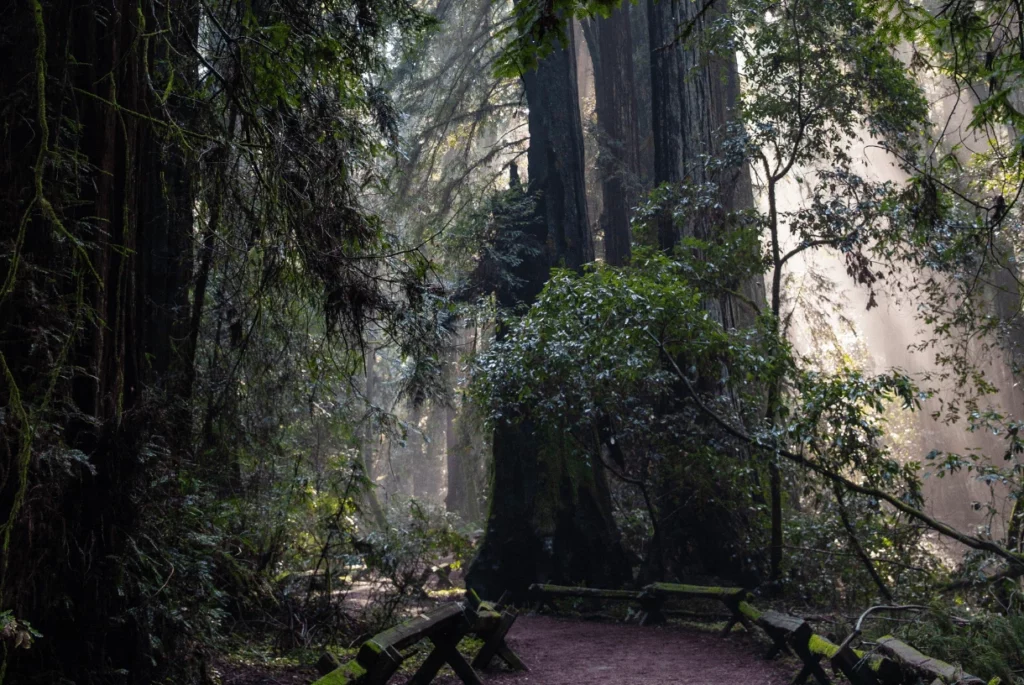
Distance from SF: 77 miles
Why go? Jack Armstrong Park is conveniently located for an afternoon trip to visit Napa or Sonoma Valley.
Located in Sonoma County, the Armstrong redwood stand is not as impressive as some other locations, but it is a great place to explore away from the crowds. Two miles of trails weave in and out of the forest and past three large trees. The Colonel Armstrong Tree is the largest and reaches more than 250 feet tall.
Know before you go. Don’t forget to visit the Redwood Theater when you are there!
10. Pfeiffer Big Sur State Park
Distance from SF: 150 miles
Why go? Stunning views of the Big Sur River, the lofty Santa Lucia Mountains, and the McWay Waterfall and Bixby Bridge on the Pacific Coast Highway.
The park’s biggest trees, like the Colonial Tree, are growing along a short, self-guided nature trail near the historic lodge. Another wonderful day hike is on the Ewoldsen Trail, which offers views of redwood groves and the Pacific Ocean.
Know before you go. Big Sur state park has 189 campsites that allow you to pitch a tent amidst the massive trees and alongside the river. Reserve them early!
11. Calaveras Big Trees State Park
Distance from SF: 162 miles
Why go? A spectacularly beautiful place to experience the Giant Sequoias in spring with blooming dogwoods, in summer with trails open to the entire park, in fall with the dogwoods changing to their fall colors, and in winter with annual snowfall.
After their discovery by Augustus T. Dowd, demand to see the giant redwoods in this area was immediate. Tourists began arriving at the Calaveras North Grove by 1853. The park’s North Grove is the longest continuously operating tourist attraction in California, and perhaps anywhere west of the Mississippi.
Calaveras Big Trees State Park is one of the easiest places to see towering trees and preserves two groves of Giant Sequoias. In addition to the giant trees, you will find the Stanislaus River, Beaver Creek, ancient volcanic formations, and natural meadows. There is also a wonderful museum where you can learn about local wildlife and view two short videos that are educational and enjoyable for all ages.
Know before you go. You can reserve a site at one of the two large campgrounds or tent sites in advance. Summer is the busiest time of year. Spring offers showy white dogwood blossoms.
12. Tuolumne Grove in Yosemite Park
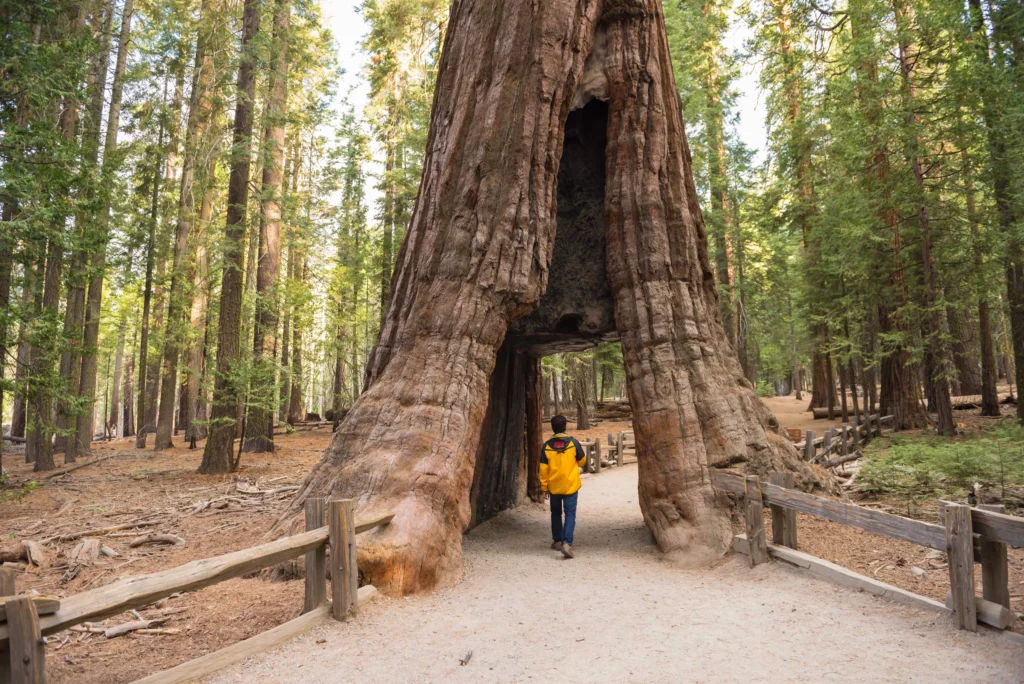
Distance from SF: 175 miles
Why go? An uncrowded and serene hike to a stand of old growth Giant Sequoias and the Tunnel Tree (no longer living) located just outside the Big Flat Oak entry to Yosemite National Park.
Located on Tioga Road, just east of Crane Flat, the Tuolumne Grove has about two dozen mature Giant Sequoias. The Sequoias are visible at the end of a one-mile hike with 500 feet of elevation loss (the one-mile hike back to the parking lot gains altitude and can be challenging for some).
Know before you go. After entering Yosemite park on Old Big Oak Flat Road, look for the “Entering the Tuolumne Grove of Giant Sequoias” sign. Water is not available, so bring drinking water for everyone in your group who will be hiking this trail. Parking is limited.
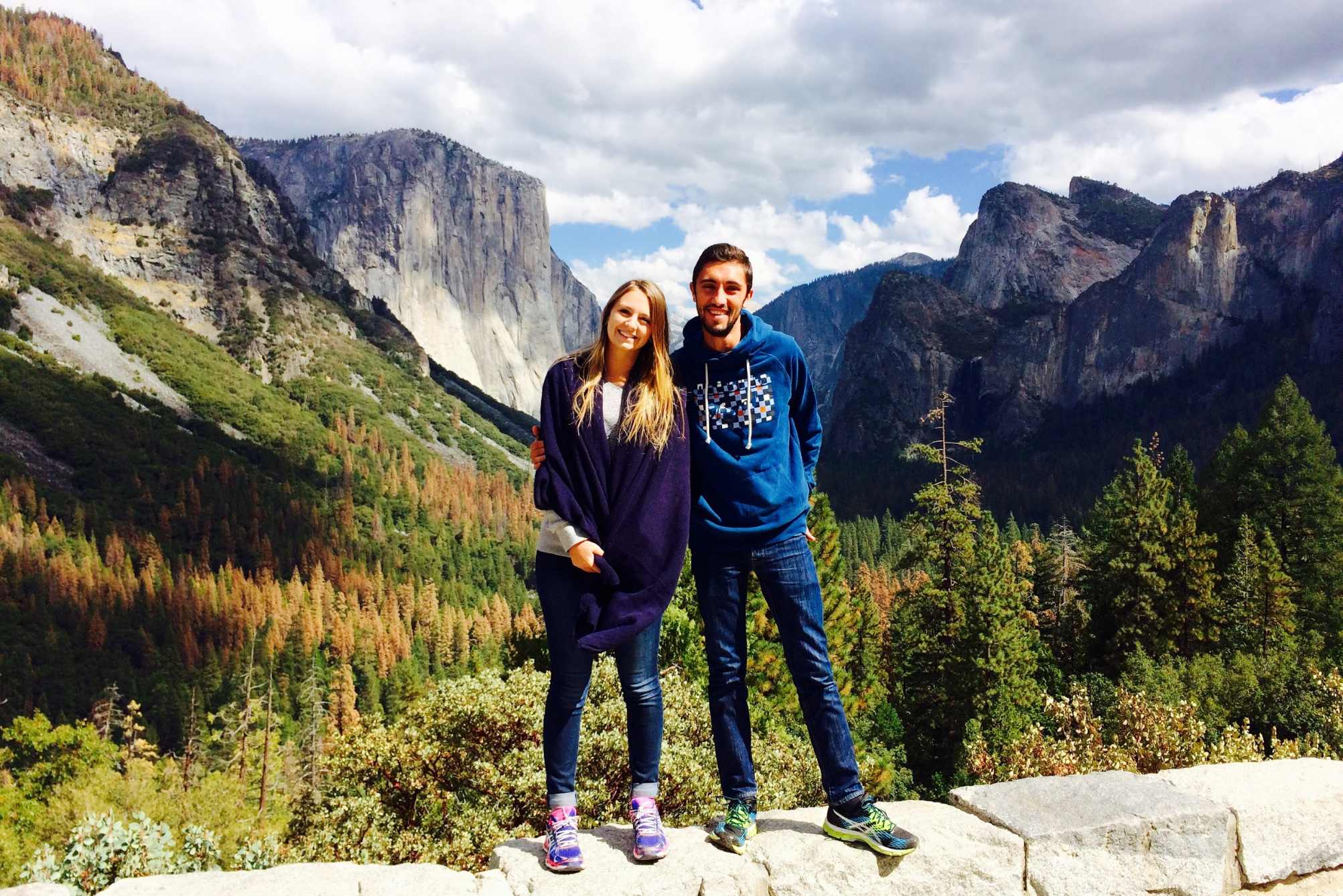
Yosemite and Giant Sequoias One Day Tour from San Francisco
The only 1-day Yosemite National Park tour from San Francisco to deliver more than you dreamed at Half Dome, El Capitan, Yosemite Falls, and on a hike to Giant Sequoias.
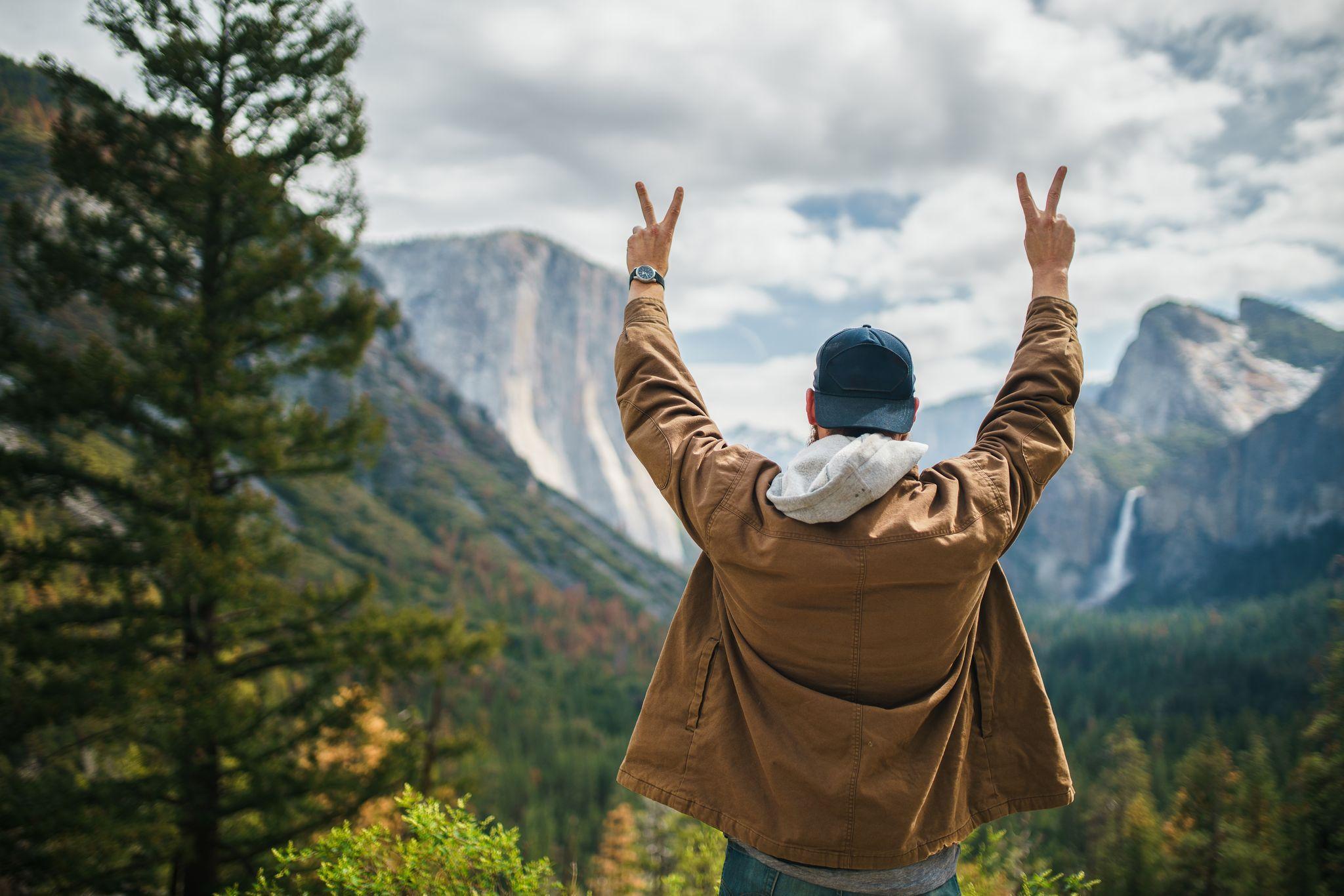
Yosemite and Giant Sequoias One Day Tour from San Jose
The only 1-day Yosemite tour from San Jose to deliver more than you dreamed at Half Dome, El Capitan, Yosemite Falls and on a hike to Giant Sequoias.
13. Mariposa Grove in Yosemite Park
Distance from SF: 210 miles
Why go? Location of the Grizzly Giant and California Tunnel Trees, and only an hour from Yosemite Valley.
Located near the South Entrance of Yosemite, the Mariposa Grove is the largest redwood grove in Yosemite National Park and is home to over 500 mature Giant Sequoias. During much of the year, a free shuttle is required for travel between the Mariposa Grove Welcome Plaza and the Mariposa Grove.
There is a variety of easy to strenuous trails within the grove. Most visitors choose the 0.8-mile hike from the parking lot to the impressive 2,000-year-old Grizzly Giant and a few that you can walk through like the California Tunnel Tree.
Know before you go. Restrooms are located at the Mariposa Grove Welcome Plaza and areas within the grove. Drinking water is available only at the welcome plaza and arrival area, so plan accordingly. Check local road conditions since Highway 140 may be closed from November through April due to snow.
14. Humboldt Redwoods State Park
Distance from SF: 217 miles
Why go? Avenue of the Giants, a scenic highway that gives you an up close experience with three giant Coastal Redwood trees without leaving your car (because you drive through them!).
A bit over 200 miles north of San Francisco is Humboldt Redwoods State Park, home to Rockefeller Forest, the world’s largest remaining continuous old growth forest of coastal redwoods. Situated along a former stretch of the original Highway 101, the 32-mile Avenue of the Giants winds through dark redwood forests.
In the early 1900s, loggers came to what is now Humboldt Redwoods State Park to cut down ancient redwoods to make shingles. The Save the Redwoods League thought that was akin to “chopping up a grandfather clock for kindling” and ultimately preserved 53,000 acres, an area almost twice the size of San Francisco, of old-growth redwood forest.
Assuming you get out of your car, Founder’s Grove is a redwood fan favorite located at the end of the Avenue of the Giants. There are dozens of moss-covered giants all around the short trail and a collection of downed, hollow, and giant trees woven perfectly into a palate of other vegetation.
Other not-to-miss spectacles are the Dyerville Giant, a fallen, 362-foot redwood behemoth that you can inspect from head to toe and the Travel Log, an RV-like vehicle carved from a redwood trunk and driven across the U.S. by conservationist Charles Kellogg.
Know before you go. Pick up an auto tour guide at the Visitor Center which is crammed with fun, historical objects and tales.
15. Kings Canyon and Sequoia National Park
Distance from SF: 237 miles
Why go? The Generals (Grand and Sherman) are reason enough to visit, but there is also America’s deepest canyon which is deeper than the Grand Canyon.
This massive, million-acre-plus Sierra playground is two separate parks administered as one by the National Parks Service. Their redwoods are not only big, but they are old, too. Scientists estimate they are between 1,800 and 2,700 years old.
Connecting the adjacent parks, and two celebrated Giant Sequoia groves, is the Generals Highway. The new Majestic Mountain Loop is another way to experience the highlights of Sequoia and Kings Canyon National Parks, as well as Yosemite National Park.
General Sherman is the largest tree in the world and located in Sequoia National Park at the end of a relatively long trail, but it is worth it to see the massive tree up close. About 20 minutes away in Grant Grove, near Lodgepole Village, you will find the, slightly smaller, General Grant Tree.
The famous drive-through Tunnel Log cut through a fallen tree is in Giant Forest on Crescent Meadow Road.
Know before you go. Overnight options range from the luxurious Wuksachi Lodge to the rustic Bearpaw High Sierra Camp overlooking the Great Western Divide. Other activities include exploring caves and snowshoeing.
California Redwood FAQs
Where is the best place to see redwoods near San Francisco?
This can’t be answered briefly, as it depends on so many factors, like distance, tree age and size, crowd levels, hiking trail choices, and more. And the best choice for us may be different than the best choice for you!
We suggest you peruse the 15 places we chose above and pick the one that sounds like the right fit for your trip! You can keep to the coast and crane your neck up at the towering coastal redwoods in groves close to the city, or drive a bit further into the Sierra Nevadas and marvel at the massive trunks of the giant sequoias.
How far are the redwoods from San Francisco?
While there are a couple small groves of redwoods within Golden Gate Park, the nearest redwood forests to San Francisco are Dr. Aurelia Reinhardt Redwood Regional Park and Muir Woods National Monument. You can get to both in less than an hour, so they make for ideal redwood day trips.
At Muir Woods you will find breathtaking old-growth redwoods and a lot of people, whereas Reinhardt Redwood Park has smaller, younger trees and more privacy.
How old are the redwood trees in California?
Both Coastal Redwoods and Giant Sequoias are among the oldest living things around but the Sequoias are the oldest. Naturalists estimate that the “Grizzly Giant” tree in Yosemite was a sprout when Julius Caesar was crossing the Rubicon over 2000 years ago!
How do they determine the age of a giant redwood tree? Botanists study a thin layer of growing cells known as the “cambium” which covers the tree like a thimble, creating annual “rings.” The width of rings varies with thick ones forming in favorable seasons and thin rings during years of drought or cold.
Since it is not possible to make accurate counts of the rings in living redwood trees, the age of most living redwoods cannot be precisely determined but must be estimated by making comparisons with trees that have been cut down and their rings counted. For example, a wedge-shaped section of a comparatively small 15-foot-diameter Giant Sequoia on display in the Mariposa Grove Museum shows an actual ring count of 1,830 years. Since many sequoias can reach 30 feet in diameter, it is a near certainty that some of these trees are more than 3,000 years old.
How fast do California giant redwood trees grow?
When visiting Northern California, you may see shops selling small redwood sprouts. Will it take a lifetime (or more) to grow them? Don’t be discouraged! Coastal Redwoods are one of the fastest-growing conifers in the world when given the right conditions. Expect 4-8 feet of upward growth for well-cared-for trees.
Given optimal conditions, the thickness of all redwoods can increase 2 inches per year. In 100 years, that would put a well-managed tree in competition with the largest wild trees (the General Grant redwood tree is 41 feet in diameter). In the wild, sequoias compete with one another and other species for nutrients, water, sun, and space—all dramatically increasing the time needed to reach maturity.
How tall are the redwood trees in California?
In Northern California, you’ll find the world’s tallest trees, some brushing the clouds over 350 feet above the ground. These incredible trees are the largest living things on Earth. The tallest Coast Redwoods, if relocated, would cast some nice shade on top of the U.S Capitol dome!
There are other large trees in the world. Certain varieties of Eucalyptus in Tasmania, Yellow Meranti in Borneo, and the Douglas Fir of Oregon surpass 300 feet, but the Sierra Nevada mountain and California coast redwood forests remain the leaders in this heavyweight bout.
Among the redwoods, a coast redwood tree named Hyperion dwarfs them all. The tree was not discovered until 2006 and is 380 feet tall. Other giants include Helios (375 feet), Icarus (371 feet) and Daedalus (363 feet). To protect these champion redwoods from vandals, their exact locations are kept secret.
How deep do Redwood tree roots go?
Northern California is a wet place. Surprisingly though, all that water is not always easily accessible. Trees all over the world search for water with deep taproots—below-ground “branches” that seek rivers of water deep within the earth. Coast redwoods have a different approach.
Using their huge size to their advantage, they suck massive amounts of water straight out of the air! It’s hard to imagine, but redwood trees can suck up to 150 gallons of water a day from coastal fog.
This method is called “foliar uptake,” and biologists know of only 8 other plants who can do it. With fog like San Francisco’s, you would be right to guess some of them live right here in California too! Sword ferns, huckleberries, and the broadleaf Tanbark Oaks are among these amazing plants.
Their unique water retrieval method means redwoods don’t need deep roots. It may surprise many to learn that redwood roots go just 6 feet deep. So how do these giants stay steady? They send their roots out (sometimes over 100 feet!) rather than down. And they often grow in mutually beneficial groves, intertwining their roots with neighbors. This support allows them to stand strong in bad weather.
Where are the drive-through redwood trees?
Have you heard of the redwood trees you can drive a car through? As hard as it is to believe, many of these giants are more than big enough to accommodate vehicle-sized holes, and at one time the carving of these holes was a popular method to attract tourists to California.
It is probably not surprising that many of these trees, weakened by huge holes in their trunks, have since fallen. But some are still standing and can be driven through to this day! We will start with those.
The Chandelier Tree (Leggett, CA – 182 miles)
The Chandelier Tree, a 276-foot tall coastal redwood tree in Leggett, California, had a 6X6 foot hole carved through its base in the early 1930s. Its name comes from its unique limbs that resemble a chandelier and measure from 4 to 7 ft in diameter.
The Chandelier Tree grows within a private redwood forest, but you can pay a small fee to drive through.
The Shine Drive-Thru Tree (Myers Flat, CA – 221 miles)
The Shine Drive Thru Tree stands just south of Humboldt Redwoods State Park, about a 4 hour drive from San Francisco. It was actually hollowed out by lightning rather than man. Although the snag is now supported by cables, it is still standing and can still be driven through for a small fee.
Dead Giant Tunnel Tree (Yosemite National Park – 175 miles)
The Dead Giant in Tuolumne Grove in Yosemite National Park was actually the first standing sequoia to be tunneled in 1878. While it was driven through for decades, it is now part of the Tuolumne Grove trail system and can only be walked through.
An hour-long loop path passes through the base of the former tree (now a burnt stump) and continues past a peaceful stand of other Giant Sequoias. You can visit this location on Extranomical Tours’ Giant Sequoias and Yosemite National Park 1-day tour or by booking a Yosemite private tour.
Fallen Tunnel Tree (Yosemite National Park – 210 miles)
In 1881, in the Mariposa Grove of Giant Sequoias, near what is today Yosemite National Park, a tunnel was carved through the Wawona “Tunnel” tree. The Scribner brothers were paid $75 for the job!
The tunnel was big enough for people to drive their carriages — and later their cars — right through. The 2,100-year-old tree fell in 1969 during a heavy snowstorm and is now known as the Fallen Tunnel Tree.
California Tunnel Tree (Yosemite National Park – 210 miles)
Thankfully, there is a walk-through tree in Mariposa Grove that is still standing (and still alive!). The California Tunnel Tree was tunneled in 1895 to allow passage for horse-drawn carriages.. Find it along the Grizzly Giant Trail.
The Pioneer Cabin Tree (Calaveras Big Trees State Park – 162 miles)
The Pioneer Cabin Tree located in Calaveras Big Trees State Park got its name from its distinctively hollow trunk formed by lightning strikes and a forest fire. It had small compartments reminiscent of a log cabin, a chimney, and a small backdoor opening.
Unfortunately, local flooding, combined with the shallow root system of Giant Sequoia, caused it to fall on January 8, 2017.
Tunnel Log (Sequoia National Park – 262 miles)
For a slightly different experience, head to Tunnel Log at Sequoia National Park. Tunnel Log, along the Crescent Meadow Road, is a fallen tree with an arched section cut out for the road. The opening is 17 feet wide and 8 feet high, with a bypass for taller vehicles. In this same area, you can find Tharp’s Log, a fallen tree that a 19th-century cattleman turned into his home.
Planning your trip to the Redwoods
We hope this article will help you plan your visit to California to experience our breathtaking redwood forests. Every one of the above parks provides something special to discover, and we recommend visiting more than one if you can!
Even if you’re planning only a one or two-day visit to the parks near the San Francisco Bay Area, you can experience California’s Coast Redwoods and Giant Sequoias. The easiest and more assured way is to book a Muir Woods Tour or Yosemite tour with a local operating company (like Extranomical Tours!) so you can sit back and let a “local insider” guide take you there. Your group will arrive relaxed and more informed about the places you’re visiting.
In case you want to go farther afield and visit one of the more than 50 other redwood parks along our coasts and in the Sierra Nevada Mountains, here is the only complete cataloged list of California Coast Redwoods and Giant Sequoia public areas. Happy redwood tree basking!
Complete List of California Coast Redwoods & Giant Sequoias
- Admiral Standley State Recreation Area, Branscomb Rd, Branscomb, CA 95417
- Andrew Molera State Park, 45500 CA-1, Big Sur, CA 93920 (State Park)
- Armstrong Redwoods State Natural Reserve, 17000 Armstrong Woods Rd, Guerneville, CA 95446 (State Natural Reserve)
- Austin Creek State Recreation, 17000 Armstrong Woods Rd, Guerneville, CA 95446
- Benbow Lake State Recreation Area, 445 Lake Benbow Dr, Garberville, CA 95542
- Big Basin Redwoods State Park, 21600 Big Basin Way, Boulder Creek, CA 95006
- Bothe-Napa Valley State Park, 3801 St Helena Hwy, Calistoga, CA 94515
- Butano State Park, 1500 Cloverdale Rd, Pescadero, CA 94060
- Calaveras Big Trees State Park, 1170 CA-4, Arnold, CA 95223
- Castle Rock State Park, 15451 CA-35, Los Gatos, CA 95033
- Del Norte Coast Redwoods State Park, Crescent City, CA 95531
- The Forest of Nisene Marks State Park, Aptos Creek Rd, Aptos, CA 95003 (State Park)
- Fort Humboldt State Historic Park, 3431 Fort Ave, Eureka, CA 95503 (State Park)
- Fort Ross State Historic Park, 19005 Coast Hwy, Jenner, CA 95450 (State Park)
- Garrapata State Park, 34500 CA-1, Carmel-By-The-Sea, CA 93923 (State Park)
- Grizzly Creek Redwoods State Park, 16949 CA-36, Carlotta, CA 95528 (State Park)
- Hendy Woods State Park, 18599 Philo Greenwood Rd, Philo, CA 9546 (State Park)
- Henry Cowell Redwoods State Park, 101 N Big Trees Park Rd, Felton, CA 95018 (State Park)
- Humboldt Lagoons State Park, 15336 US-101, Trinidad, CA 95570 (State Park)
- Humboldt Redwoods State Park, 17119 Avenue of the Giants, Weott, CA 95571 (State Park)
- Jug Handle State Natural Reserve, CA-1, Fort Bragg, CA 95437 (State Natural Reserve)
- Julia Pfeiffer Burns State Park, 52801 California State Route 1, Big Sur, CA 93920 (State Park)
- Jedediah Smith Redwoods State Park, Yorkville, CA 95494 (State Park)
- Jack London State Historic Park, 2400 London Ranch Rd, Glen Ellen, CA 9544 (State Park, California Historical Landmark, National Historic Landmark)
- Kings Canyon (National Park)
- Kruse Rhododendron State Natural Reserve, Cazadero, CA 95421 (State Natural Reserve)
- Limekiln State Park, 63025 CA-1, Big Sur, CA 93920 (State Park)
- Mailliard Redwoods State Natural Reserve, Yorkville, CA 95494 (State Natural Reserve)
- Mendocino Headlands State Park, Mendocino, CA 95460 (State Park)
- Mendocino Woodlands State Park, Little Lake Road, Mendocino (State Park)
- Montgomery Woods State Reserve, 15825 Orr Springs Rd, Ukiah, CA 95482 (State Natural Reserve)
- Mount Tamalpais State Park, 3801 Panoramic Hwy (State Park)
- Muir Woods National Monument, 1 Muir Woods Rd, Mill Valley, CA 94941 (National Monument)
- Navarro River Redwoods State Park, Elk, CA 95432 (State Park)
- Patricks Point State Park, 4150 Patricks Point Dr, Trinidad, CA 95570 (State Park)
- Pfeiffer Big Sur State Park, Pfeiffer Big Sur Rd, Big Sur, CA 93920 (State Park)
- Portola Redwoods State Park, Redwood Gate, 7867 Redwood Rd, Oakland, CA 94619 (State Park)
- Prairie Creek Redwoods State Park, 127011 Newton B. Drury Scenic Pkwy, Orick, CA 95555 (State Park)
- Purisima Creek Redwoods Preserve, Half Moon Bay, CA 94019 (Nature Preserve)
- Redwood Grove Nature Preserve, 482 University Ave, Los Altos, CA 94022 (City Park)
- Redwood National Park (1), 2415 Western Ave, Sacramento, CA 95815 (National Park)
- Redwood National Park (2), 3097 Redwood Ave, West Sacramento, CA 95691 (National Park)
- Reinhardt Redwood Regional Park, 7867 Redwood Rd, Oakland, CA 94619 (Regional Park)
- Richardson Grove State Park, 1600 US-101, Garberville, CA 95542 (State Park)
- Roys Redwoods Preserve, Woodacre, CA 94973 (County Park)
- Russian Gulch State Park, CA-1, Mendocino, CA 95460 (State Park)
- Samuel P Taylor State Park, 8889 Sir Francis Drake Blvd, Lagunitas, CA 94938 (State Park)
- Salt Point State Park, 25050 CA-1, Jenner, CA 95450 (State Park)
- Sinkyone Wilderness State Park, Whitethorn, CA 95589 (State Park)
- Smithe Redwoods State Natural Reserve, 73201 US-101, Piercy, CA 95587 (State Natural Reserve)
- Sequoia National Park
- Sonoma Coast State Park, 3095 CA-1, Bodega Bay, CA 94923 (State Park)
- Standish-Hickey State Recreation Area, Leggett, CA 95585 (State Recreation Area)
- Trione-Annadel State Park, 6201 Channel Dr, Santa Rosa, CA 95409 (State Park)
- Van Damme State Park, 8001 CA-1, Little River, CA 95456 (State Park)
- Transamerica Redwood Park, 600 Montgomery St, San Francisco, CA 94111 (Corporate Pocket Park)
- Wilder Ranch State Park, 1401 Coast Rd, Santa Cruz, CA 95060 (State Park)
- Yosemite National Park: the Mariposa, Tuolumne and Merced Redwood Groves (National Park)
